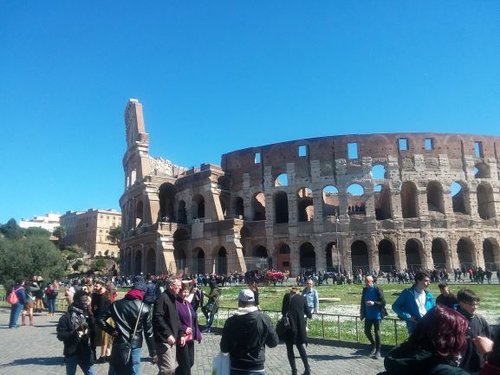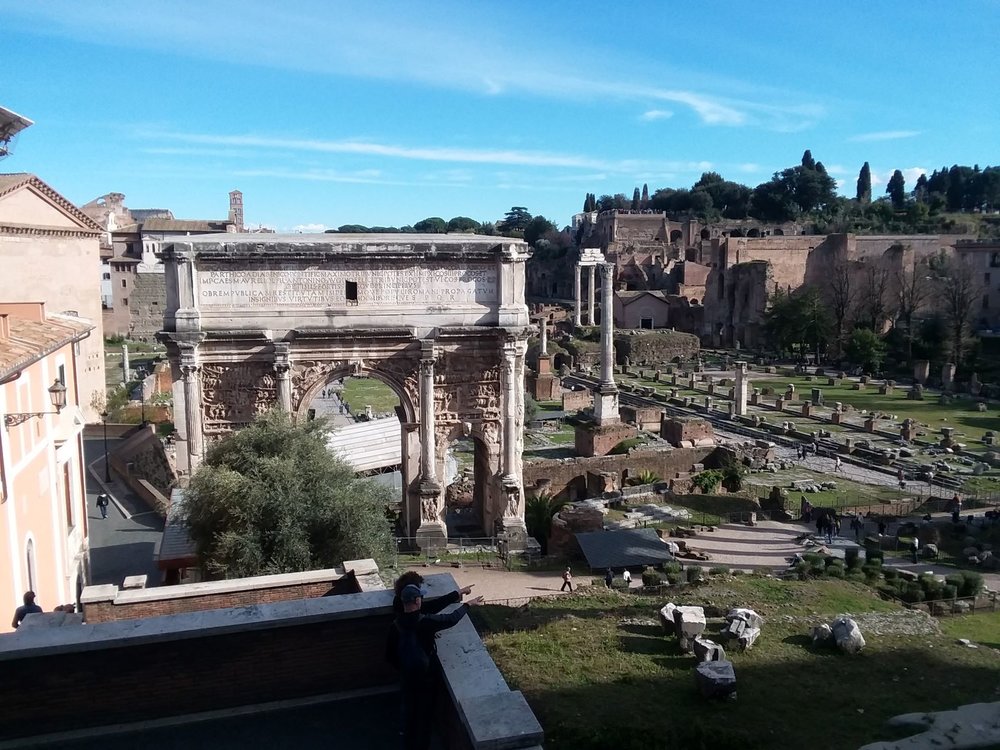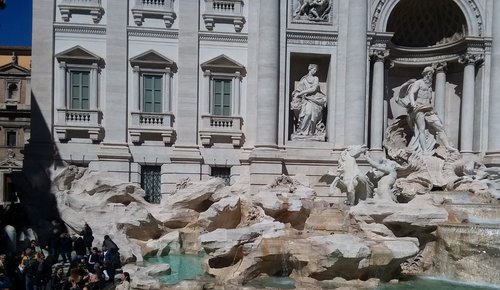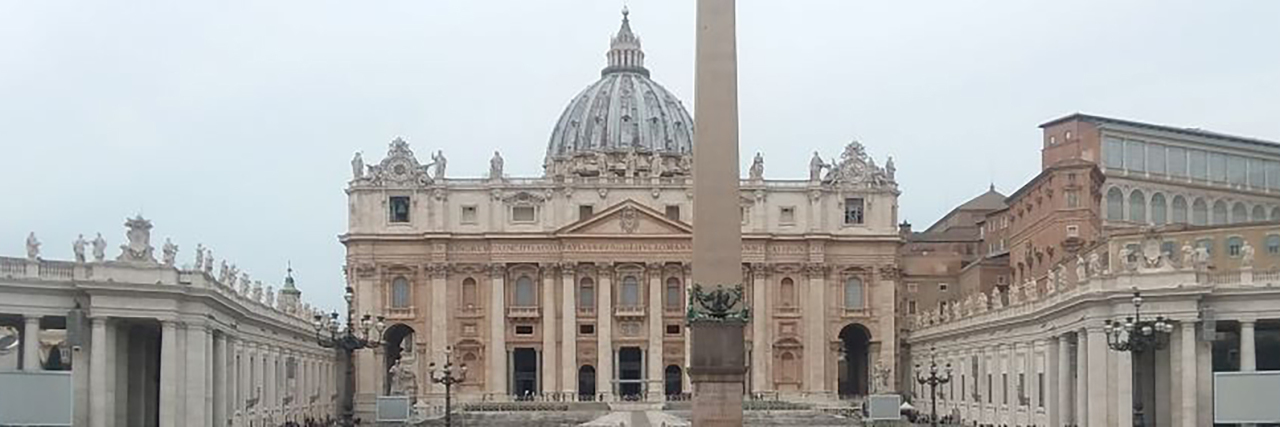From March 11 to March 15, 2019, I roamed around Rome and Assisi, Italy in my portable wheelchair. Here’s the accessibility assessment of my adventures. I’ll organize my assessment in the order I encountered the features about which I will be sharing my experiences.
The Vatican Museum
The objects in this museum are from various centuries and have been either found in Vatican City or gifted to the Vatican.
I recommend ignoring the vendors offering to sell you tickets so you can avoid the line at the museum. Sometimes these vendors say they will also be giving you your own personal tour. My group purchased our tickets inside the museum. As a wheelchair user, I did not have to wait in line. Furthermore, because I am a wheelchair user, my ticket and the ticket of one of my companions was free. I don’t think the tour guide is necessary, as once you get inside the museum, you may also purchase an audio guide. I did not purchase an audio guide and found it enjoyable just to look at the architecture and the objects on display.
A significant portion of this museum is wheelchair accessible. There is an accessible route through the museum that is different from the direction in which crowds are usually sent. There is a standard elevator up to the main museum level and down to the cafeteria. A wheelchair lift is available to provide access to the Sistine Chapel. Signs will direct you to accessible routes, and there are plenty of multilingual staff members posted throughout the museum to guide visitors.
St. Peter’s Square and St. Peter’s Basilica

There are ramps onto the square and into the main level of the basilica. One companion and I were offered the opportunity to avoid the line on the square and to access the ramp there. We chose to keep our party together and to have someone lift my chair up the couple of steps. The line moved quickly. The speed at which it moved may have been partly because we visited in the morning. I highly recommend visiting any of the major tourist sites in Rome at this time of day. If you are visiting in the summer, you will have even more reason to hit the high points in the mornings. Roman summers are hot! There is also an elevator in St. Peter’s Basilica that provides access to some of the papal tombs underneath. The tomb of St. Peter can be accessed using this elevator.
Castel Sant’Angelo
This structure was originally built by Emperor Hadrian to be a tomb. It was later used as a papal fortress, castle, and prison. The entrance level is accessible, and there is an elevator to the second level. Various lookout areas on the second level provide stunning views of Rome. For the best views, I recommend visiting Castel Sant’Angelo on a sunny day.
The Coliseum

You may encounter vendors outside that have a message much the same as the ones outside Vatican City. At the Coliseum, if I remember correctly, I and the other six members of my party all got to skip the line. Once again, my ticket and the ticket of one companion was free. The level on which visitors enter is accessible, and there is an elevator up to the second level. Additionally, there are ramps leading to some parts of the stage area.
The Roman Forum

In the time of the Roman Empire, the Forum was the location of several temples and public buildings. At the entrance to the forum these days is a map of the entire complex. I recommend studying this map carefully before moving on, as it indicates accessible routes. Staff members may also be able to guide you to the accessible areas of the forum.
The members of my group later wished they had paid more attention to the map. We learned only by accident, after members of my group had pulled my chair up several hills and over giant rutted cobblestones, that there is a smooth path leading to an elevator. This elevator provides access to certain parts of the forum.
Assisi
This town is the very definition of quaint and hilly. I don’t remember the streets being covered in cobblestones, large or small, as many streets are in Rome, but I do remember the sidewalks felt like they were paved with bricks. Most shops that line the main street have one or two steps leading into them. From my perspective, Assisi is a town consisting of two steep hills with a church at the top of each one, and the main street connecting the churches. These churches, the Basilicas of St. Clare and St. Francis, are examples of Italian Gothic architecture.
Many accessible vehicles may be too large to be allowed into the streets of Assisi. To visit Assisi, I had to be transferred out of my chair and into a seven-passenger van. When we got to Assisi after about a two-hour drive from Rome, it was difficult for my parents to push my chair up the hills and to keep my chair from rolling down the hills at full speed. Nevertheless, if there is a way for a wheelchair user to be dropped off at the basilicas, I recommend visiting them. The remains of St. Clare are interred on the lower level of her basilica. Unfortunately, this level of the church is not accessible to wheelchair users.
Similarly, St. Francis is buried in the lower level of the basilica named to honor him. I was told there is a wheelchair lift to access this tomb, but I chose not to do so. I was under the impression that asking to do so would require making certain arrangements or finding certain people, and I didn’t want to delay my group.
The Basilica of St. Clare
If you don’t think you can navigate Assisi safely in your wheelchair, and you happen to know someone else who’s going there, see if they will bring you back a souvenir from one of the shops. Some shops may offer items that are hard to find elsewhere. A necklace pendant patterned after the rose window in one of the basilicas comes to mind.
The Trevi Fountain

On March 14, we were back in Rome, and made our way to the Trevi Fountain. Its Baroque statues and carvings should stay looking great for years to come, as the fountain has recently been cleaned, and when the sun is out, its white is so bright, it’s almost painful to look at. Visitors from all over the world toss in coins and make wishes. They also take plenty of pictures, and for good reason.
The roads that lead to the fountain are cobblestone and a bit bumpy for wheelchair tires, but the stones in this area of the city aren’t as large as the ones on the forum, and they aren’t spaced as far apart either, so the ride is smoother.
The Pantheon (also called the Church of St. Mary and the Martyrs)
This structure is a largely intact temple from ancient Rome. The round building with a circle cut out of its dome was constructed as a temple to all the Roman gods, hence the name “Pantheon.” Its floors, walls and dome are original to the construction of the temple. Today, you will find pews and Christian statues inside, as the structure was converted to a church in 609 A.D. There is a ramp into the building, and as the structure consists of one circular room, there’s nowhere a wheelchair user can’t go once he or she arrives at the Pantheon.
The Etruscan Museum at the Villa Giulia
This museum displays artifacts, pottery, jewelry, statues, and temple fragments from the civilization that lived in the area before the Romans did. It is accessible using a series of elevators and stair lifts. We repeatedly had to ask staff for help to find the right elevator because so many different elevators and lifts provide access to the sprawling, multilevel Renaissance palace. Unfortunately, (or maybe fortunately from a wheelchair accessibility standpoint) the Renaissance architecture is largely invisible from the inside of the museum. The interior, for the most part, has been replaced with ultramodern flooring, walls, and ceilings.
I recommend a walk along the building’s many courtyards. Such a walk gives visitors a feel for the building’s architecture. Stroll the outdoor areas of the second level and look down on the courtyards and mosaic work below. If you can find accessible transportation directly to the museum, I recommend taking it. The park where the villa is located is expansive, and we had to take quite a hike to get there from just outside the park. We even had to ask for directions when we were already in the park.
So Many Other Basilicas and Churches
Given that it’s Rome we’re discussing here, there are so many other basilicas and churches a traveler could include in this blog. We visited several churches and didn’t even make it to all the ones designated “major basilicas.” Each church has its distinguishing design characteristics and features, whether those features are artwork by Michelangelo or Caravaggio or the church houses notable relics or a crucifix that miraculously survived a medieval blaze.
When in Rome, you will find a church in any direction you turn, and you will find more than one church without having to walk very far in any direction. I recommend that you consult a guidebook for complete listing of all the major basilicas. I think all of these provide access for wheelchair users, as they are common places of pilgrimage for people from all walks of life. Of the churches that are not designated as major basilicas, some will have ramps and some won’t. We visited churches that did and churches that didn’t.
Wheelchair-Accessible Restrooms and Buses
This is a list of locations where I found wheelchair-accessible restrooms:
- St. Peter’s Basilica and the Vatican Museum
- The Coliseum
- The Forum
- Castel Sant’Angelo
- The center of Assisi and the Basilica of St. Francis — The accessible restrooms are near the Basilica of St. Francis, not inside. Other accessible restrooms are roughly between the two basilicas, as well as where tour buses and vans park outside the gates of the city. I used the ones at the Basilica of St. Francis. I tried to use the ones in the parking area, but the accessible restroom was locked.
It may be helpful to know about a few common design characteristics of accessible restrooms in Rome and Assisi:
- Unlike in the United States, where you’ll often find supposedly accessible stalls inside both the men’s and women’s restrooms, in Rome and in other parts of Europe I’ve been to recently, there has always been only one accessible toilet in its own very large room. Still, I never encountered an occupied accessible restroom or a line waiting to access the accessible restroom. There are not separate accessible toilets for men and women. This unisex arrangement is handy for people whose companions may be the opposite gender.
- Most public accessible toilets don’t include seats. This is somewhat of a problem for someone like me who has balance issues and would normally sit on the seat. The accessible restrooms at The Forum had a toilet seat.
- There are grab bars on either side of the toilet. They are paperclip shaped and attached to the back wall. They are designed to swing from a vertical to a horizontal position, in other words to move from being parallel to the back of the toilet to extending past the length of the commode. Because they are designed to swing up and down, my mom and I didn’t immediately recognize that they were grab bars when we first walked into one of these restrooms. One of the bars unexpectedly swung out of the upright position and bumped my mom.
Finding an Accessible Restroom When You’re Not At a Well-Known Attraction
When you’re not at one of the attractions listed above, you’ll have to do some looking to find a wheelchair accessible restroom. I read on last year that international fast food chains require their restrooms to meet accessibility standards. I had occasion to test this claim on this trip. In one McDonald’s I stopped into, there was a restroom as spacious as and similarly designed to the ones at the facilities listed above. The catch: my chair had to be lifted up three steps before I could get into the McDonald’s to use the perfectly accessible restroom.
When we visited the base of the Spanish steps, I went into a McDonald’s nearby, hoping to use the restroom there. This location did not have an accessible restroom that we could see. There was a McCafe on the street level of the location, and it looked like there were two flights of stairs up to the traditional McDonald’s part of the store.
That day, we found accessible restroom in a jazz club I forgot to get the name of. I know two things: it was in the area of those famous steps and it had a toilet seat. As a result of the discovery of this restroom, I would recommend looking for theaters and other similar establishments if you are looking for an accessible restroom and are not headed to a famous location.
Accessible Transportation
There was a train station near the apartments where we stayed. It had a ramp on the outside, but we were told we would eventually encounter stairs in the train and subway system, so we didn’t use it. We used the bus system. All the city buses have ramps the driver can pull down to let wheelchair users onto the bus. Buses to tourist areas tended to be crowded, but ambulatory bus passengers were very kind about making room for my chair if the lack of space allowed for any shifting at all. There’s an accessible tram system, but according to RomeMap 360 and Civitatis Rome, its lines cover only 24 miles and are not particularly near to popular tourist attractions.
Photos by Jim Rutledge.

